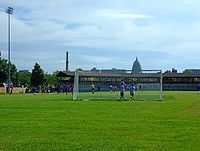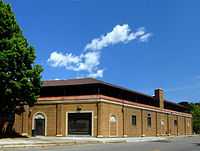Breese Stevens Field


_marker_(1934)_on_Breese_Stevens_Field_in_Madison%2C_Wisconsin_CWA_marker.jpg)
Breese Stevens Municipal Athletic Field is the oldest athletic field owned and operated by the city of Madison, Wisconsin. Located eight blocks northeast of the Wisconsin State Capitol on the Madison Isthmus, it is the oldest extant masonry grandstand in Wisconsin. "Breese," as it is known, has also hosted circuses, midget car racing, ice skating, track and field, Madison Scouts Drum and Bugle Corps competitions, concerts, boxing and wrestling events.
It is currently home to Edgewood College, the Madison 56ers amateur soccer team, and the professional Ultimate frisbee team the Madison Radicals. It has also hosted Wisconsin Interscholastic Athletic Association's girls soccer tournaments in recent years and an exhibition match of Australian Football between the Milwaukee Bombers and Minnesota Freeze.
The field is named in honor of Breese J. Stevens (1834–1903), a New York native who came to Wisconsin in 1856 to look after family land interests. Stevens became mayor of Madison in 1884 and a University of Wisconsin–Madison regent in 1891. This complex is a Madison Landmark and was nominated by the Madison Trust in 1995. It was accepted for inclusion on the National Register of Historic Places and the Wisconsin State Register of Historic Places by the Wisconsin Historic Preservation Review Board on November 21, 2014.
History
Acquiring the park
Addressing the concern that Madison's sports facilities were insufficient, the city council began efforts to establish a new athletic field in 1922.[1] After first trying to obtain the land by donation, a joint committee of the council and the Association of Commerce considered sites such as Olbrich Park and what is today's Georgia O'Keeffe Middle School playground.[2] The council ultimately decided on a block of 18 lots fronting East Washington Avenue and bounded by Mifflin, Brearly and Paterson streets. Having the advantage of being midway between Central and East High Schools, the property was owned by the widow of Breese Stevens.[3] To help raise money for the project state Supreme Court Judge Burr W. Jones consented to the selling of property at Livingston and East Washington that he had previously donated to the city as a playground, on condition the new athletic field be named for him.[4] Regardless, on September 28, 1923 the city council acceded to Mrs. Stevens terms that the field be named for her late husband instead, and purchased the property for $35,000 (reduced from $45,000).[5]
Construction
The city of Madison built the brick grandstand in 1925. The original grandstand structure, designed by the Madison architectural firm of Claude and Starck in the Mediterranean Revival style, was constructed from 1925 to 1926 and formally dedicated on May 5, 1926. The blueprints for Breese Stevens Field (grandstand) are located in the Elmer Anderson library at the University of Minnesota. The stone wall surrounding the perimeter was built in 1934 as a project of the Civil Works Administration using quarry rock from Madison's Hoyt Park. The concrete bleachers were also built in 1934, and the wood-press box was added in 1939. The first night baseball game in Wisconsin was held there on July 7, 1930, resulting in a defeat of the California Owls, a team that toured with its own floodlights.[6] Attendance was impressive enough that the field was outfitted with lights the next year. Until the mid-1960s, Breese was the only city park with floodlights.
Sporting events
Many of the city's major outdoor athletic events took place at Breese, including nearly all local high school football games. The field was home to the minor league baseball team the Madison Blues of the Triple-I League from 1924-1942 (They played their inaugural year on Kipp Field in 1923). The field also hosted major league teams such as the Chicago Cubs[7] and Chicago White Sox.[8] Many famous athletes played there, often in exhibition contests. Gold medal sprinter of the 1936 Berlin Olympics Jesse Owens ran in three exhibition races there in 1938.[9] In 1947 acclaimed pitcher Satchel Paige of the Negro Leagues' Kansas City Monarchs defeated the Industrial League All-Stars 14-5.[10] Warren Spahn, later the left-handed star pitcher for the Milwaukee Braves, took the Breese mound many times in 1941 as a member of the visiting Evansville Bees.[11]
By the late 1960s, Breese Stevens Field lost its status as the city's premier athletic complex as modern facilities, such as Mansfield Stadium, began to appear in suburban Madison.
Revival
In the 1980s, the city planned to demolish the structure, but a public outcry led instead to restoration of the grandstand, the perimeter stone wall, and the bleachers. Artificial turf replaced the original grass field in 2014.
Since 2013, the Madison Radicals of the American Ultimate Disc League (AUDL) have played their home games at the field. In 2013 the Radicals made it to the AUDL Championship Game but lost to the Toronto Rush 16-14.
References
- ↑ "Plan Joint City, School Athletic Field," Capitol Times, Aug. 21, 1922
- ↑ "Engineers Draw Map of New Athletic Field," Capitol Times, Aug. 22, 1922
- ↑ "Committee To Work For City Athletic Field," Capitol Times, Jan. 13, 1923
- ↑ "Athletic Field On East Side Is New Plan," Capitol Times, Apr. 17, 1923
- ↑ "Council Votes to Buy Municipal Athletic Field," Capitol Times, Sept. 29, 1923
- ↑ "Blues Battle Owl Nine in Night Game," Capitol Times, July 7, 1930
- ↑ "Blues Hold Cubs to 1 to 1 Tie Through Eight Innings," Wisconsin State Journal, July 12, 1938
- ↑ "White Sox Lambast Blues, 13-3," Capitol Times, Aug. 10, 1928
- ↑ "Owens Steps 100 Yards in :09.8; Blues Win Again," Wisconsin State Journal, Aug. 5, 1938
- ↑ "Monarchs Crush All-Stars 14-5," Wisconsin State Journal, July 18, 1947.
- ↑ "Blues Check Rally in Ninth to Win 6-5; Cafego's Homer Helps," Wisconsin State Journal, May 25, 1941
External links
- "A Glimpse at Breese Stevens Field" from the Newsletter of the Tenney-Lapham Neighborhood Association
- "Breese Stevens Field gets recognized as a national landmark", Isthmus, 5 December 2014
Coordinates: 43°04′59″N 89°22′23″W / 43.08306°N 89.37306°W